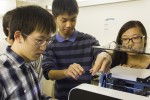3-D printers can precisely stack thin layers of plastic to create salt shakers, whistles and sculptures of Pikachu. By next quarter, UCLA students hope to print several parts that will combine to make a prosthetic hand.
A UCLA 3-D printing club, called 3-D For Everyone, is partnering with the UCLA women’s basketball team and the Biomedical Engineering Society to create prosthetic hands that can give children born with hand deformities a chance to play basketball.
UCLA’s chapter of 3-D For Everyone, or 3D4E, is an intercollegiate club for students interested in 3-D printing. This quarter, the club is working to create a 3-D printer using 3-D printed parts, teach underprivileged youth engineering skills and launch the Open Hand Project to produce 3-D printed prosthetic hands for children.
Brooke Zampell, public relations chair for 3D4E and a second-year bioengineering student, said Enabling the Future, an online charity that has distributed approximately 1,500 3-D printed hands to children in 37 countries, inspired the club to start the project.
Zampell said 3D4E will be using Enabling the Future’s prosthetic hand design, called the Raptor Reloaded, as a model for the hands they plan to produce. The five fingers, the palm and the wrist are each printed separately and then assembled.
She added the group chose the design because they thought it would be durable enough to allow children to play basketball.
“What we are trying to do is give the hand an athletic ability,” Zampell said. “Our goal is to make a bunch of these hands, invite the kids to campus and give them a daylong workshop with the women’s basketball team.”
Richard Kidd, media director for the women’s basketball team, said 3D4E pitched the project to the team earlier this year. The two groups have since planned to create a workshop to teach children how to play basketball with their new prosthetic hands, furthering the women’s basketball team’s goal of community involvement.
Before students print these prosthetic hands, they plan to adjust the design. Merrick Campbell, 3D4E project lead and vice president, said the current design closes the fingers when the wrist is bent backwards, which is problematic for playing basketball.
“We want to adjust the position of the fingers so they can better grip the ball,” said Campbell, a fourth-year mechanical engineering student. “We need to reverse the direction the fingers close.”
The student group will use two printers to test their prototypes and to produce the final product. Campbell said the model also uses metal hardware and nylon strings that will act as the hand’s tendons.
Andrew Jann, president of UCLA’s Biomedical Engineering Society, or BMES, and fourth-year biomedical engineering student, said BMES students contribute their ideas and engineering abilities to the project. He thinks 3D4E’s project is a good opportunity to help introduce new members to the club.
“We plan on using the project to teach club members basic engineering concepts and skills,” Jann said. “The impact 3-D printing will have on the future is huge. It enables us to quickly produce customizable parts for biomedical purposes.”
Campbell said 3-D printing introduces a new, wide-ranging set of possibilities for consumers.
“3-D printing offers people complete customization in the physical world,” Campbell said. “I am really excited to see what is going to happen in the next decade with this technology.”
The club plans to finalize the design by winter quarter and host the workshop with the women’s basketball team in the spring.
